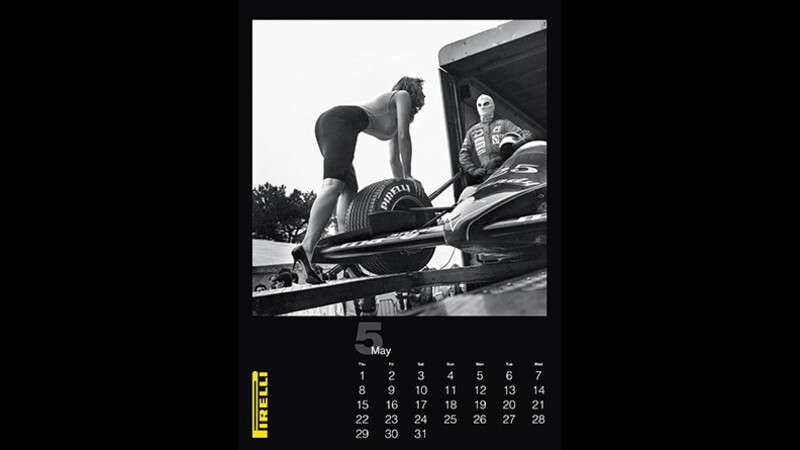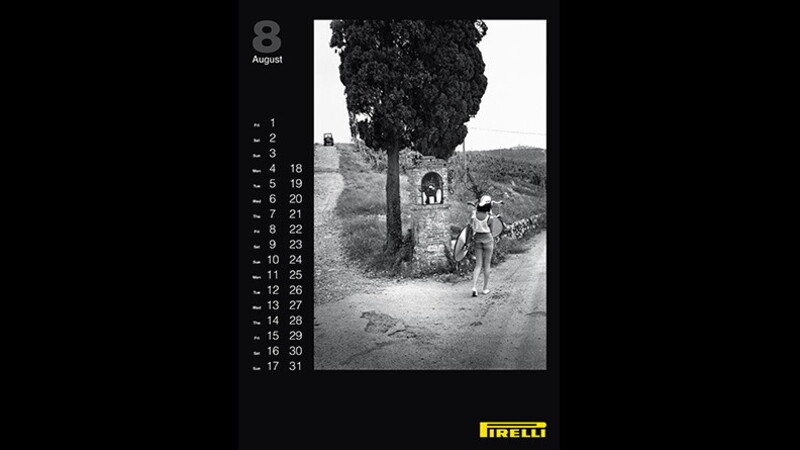When in the spring of 1985, Pirelli Italia asked Helmut Newton to envision the Calendar, the company did not place any restrictions on his creativity, but specified that the Pirelli product had to appear in the photographs. This was a new development, not just for the renowned photographer but also for the Calendar, which until then had focused on evocative images that were far removed from Pirelli's core business. All the different models of Pirelli tyres therefore appeared on the set for the Italian shoot.

Until then any product placement had been extremely subtle -at the most, as described above, limited to tyre tracks in the sand (Uwe Ommer, The Cal™ 1984), or the cinturato graphic motif on the costumes worn by the models (Norman Parkinson, The Cal™ 1985). Newton, who was well aware of the Calendar's renown, decided to take up the challenge.

The first shots were taken in May, on occasion of the Grand Prix in MonteCarlo, which was also where the photographer had his home. The next location chosen was Podere Terreno in Chianti, Tuscany, and it was among the vineyards and countryside around Siena that Newton found the right light for his interpretation of the Italian version of “The Cal”™. Rolling hills, cypress trees, farmhouses, shrines, agricultural machinery, a small petrol station and Medieval villages were the backdrop for images that conveyed a quintessentially neo-realist atmosphere.
The Tuscan roads lent background perspective to his intense, voluptuous women, who evoked the stars of Italian neorealist films such as Silvana Mangano, Lucia Bosé and Sophia Loren, observed by men who featured purely as spectators.
Ever by Newton's side was Manuela Pavesi. Much more than a stylist, it was her job to interpret the spirit of that haughty, restless vision of femininity, and help set the scene. Newton, with his love of vitality and vibrant eroticism, put his imagination to work in the search for a sensual style that would convey his vision of the Italian identity. Manuela Pavesi worked with him on the creative and practical aspects, sharing his bold, instinctive approach, with an unusual talent for turning provocative contents into glossy images.

And when Helmut Newton was forced to leave the set to return to MonteCarlo on urgent family business, it was Pavesi who took charge of his camera, with precise instructions on how it was to be positioned. The finger on the shutter was that of the assistant Xavier Alloncle, but the work, which was practically already in the can, bore Newton's artistic hallmark.
The Calendar shot by Helmut Newton in 1985 was kept under wraps in Pirelli's archives and then reconstructed and published almost 30 years alter, thus becoming the 2014 Pirelli Calendar.
The 2014 Pirelli Calendar respects the original project in terms of layout too, presents 12 black and white fine art photographs accompanied with 29 backstage shots that will give aficionados a glimpse behind the scenes of the historic shots captured in Chianti and Monte Carlo in 1985.
The edition has been produced with the utmost respect for Newton's idea of the original project. The photographs follow his creative concept, and the end product has been edited to faithfully reflect his artistic vision.




